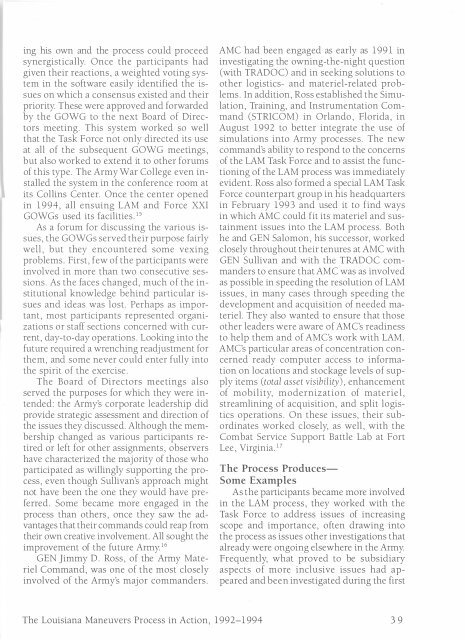The Modern Louisiana Maneuvers - US Army Center Of Military History
The Modern Louisiana Maneuvers - US Army Center Of Military History
The Modern Louisiana Maneuvers - US Army Center Of Military History
Create successful ePaper yourself
Turn your PDF publications into a flip-book with our unique Google optimized e-Paper software.
ing his own and the process could proceed<br />
synergistically. Once the participants had<br />
given their reactions, a weighted voting system<br />
in the software easily identified the issues<br />
on which a consensus existed and their<br />
priority. <strong>The</strong>se were approved and forwarded<br />
by the GOWG to the next Board of Directors<br />
meeting. This system worked so well<br />
that the Task Force not only directed its use<br />
at all of the subsequent GOWG meetings,<br />
but also worked to extend it to other forums<br />
of this type. <strong>The</strong> <strong>Army</strong> War College even installed<br />
the system in the conference room at<br />
its Collins <strong>Center</strong>. Once the center opened<br />
in 1994, all ensuing LAM and Force XXI<br />
GOWGs used its facilities.15<br />
As a forum for discussing the various issues,<br />
the GOWGs served their purpose fairly<br />
well, but they encountered some vexing<br />
problems. First, few of the participants were<br />
involved in more than two consecutive sessions.<br />
As the faces changed, much of the institutional<br />
knowledge behind particular issues<br />
and ideas was lost. Perhaps as important,<br />
most participants represented organizations<br />
or staff sections concerned with current,<br />
day-to-day operations. Looking into the<br />
future required a wrenching readjustment for<br />
them, and some never could enter fully into<br />
the spirit of the exercise.<br />
<strong>The</strong> Board of Directors meetings also<br />
served the purposes for which they were intended:<br />
the <strong>Army</strong>'s corporate leadership did<br />
provide strategic assessment and direction of<br />
the issues they discussed. Although the membership<br />
changed as various participants retired<br />
or left for other assignments, observers<br />
have characterized the maj ority of those who<br />
participated as willingly supporting the process,<br />
even though Sullivan's approach might<br />
not have been the one they would have preferred.<br />
Some became more engaged in the<br />
process than others, once they saw the advantages<br />
that their commands could reap from<br />
their own creative involvement. All sought the<br />
improvement of the future <strong>Army</strong>. 16<br />
GEN Jimmy D. Ross, of the <strong>Army</strong> Materiel<br />
Command, was one of the most closely<br />
involved of the <strong>Army</strong>'s major commanders.<br />
AMC had been engaged as early as 1991 in<br />
investigating the owning-the-night question<br />
(with TRADOC) and in seeking solutions to<br />
other logistics- and materiel-related problems.<br />
In addition, Ross established the Simulation,<br />
Training, and Instrumentation Command<br />
(STRICOM) in Orlando, Florida, in<br />
August 1992 to better integrate the use of<br />
simulations into <strong>Army</strong> processes. <strong>The</strong> new<br />
command's ability to respond to the concerns<br />
of the LAM Task Force and to assist the functioning<br />
of the LAM process was immediately<br />
evident. Ross also formed a special LAM Task<br />
Force counterpart group in his headquarters<br />
in February 1993 and used it to find ways<br />
in which AMC could fit its materiel and sustainment<br />
issues into the LAM process. Both<br />
he and GEN Salomon, his successor, worked<br />
closely throughout their tenures at AMC with<br />
GEN Sullivan and with the TRADOC commanders<br />
to ensure that AMC was as involved<br />
as possible in speeding the resolution of LAM<br />
issues, in many cases through speeding the<br />
development and acquisition of needed materiel.<br />
<strong>The</strong>y also wanted to ensure that those<br />
other leaders were aware of AMC's readiness<br />
to help them and of AMC's work with LAM .<br />
AMC's particular areas of concentration concerned<br />
ready computer access to information<br />
on locations and stockage levels of supply<br />
items (total asset visibility), enhancement<br />
of mobility, modernization of materiel,<br />
streamlining of acquisition, and split logiStics<br />
operations. On these issues, their subordinates<br />
worked closely, as well, with the<br />
Combat Service Support Battle Lab at Fort<br />
Lee, Virginia 17<br />
<strong>The</strong> Process Produces<br />
Some Examples<br />
As the participants became more involved<br />
in the LAM process, they worked with the<br />
Task Force to address issues of increasing<br />
scope and importance, often drawing into<br />
the process as issues other investigations that<br />
already were ongoing elsewhere in the <strong>Army</strong>.<br />
Frequently, what proved to be subsidiary<br />
aspects of more inclusive issues had appeared<br />
and been investigated during the first<br />
<strong>The</strong> <strong>Louisiana</strong> <strong>Maneuvers</strong> Process in Action, 1992-1994 39
















